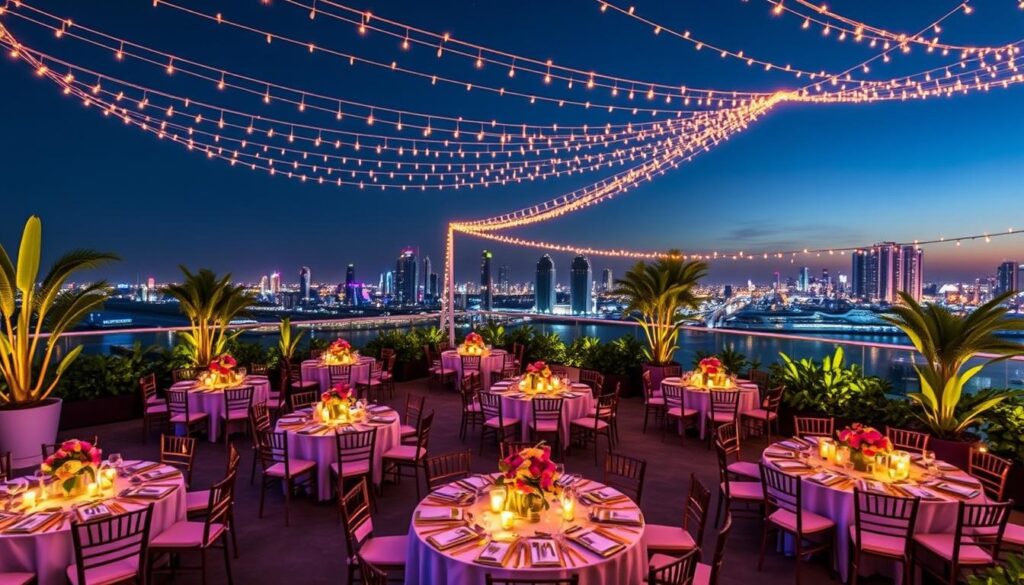Dubai has become one of the premier global hubs for events: conferences, exhibitions, product launches, gala dinners, concerts, and more. Part of what enables Event Venues in Dubai to host events at world-class quality is the innovation in venue design, management, and service. But what are the actual factors that make a space work—not just look good, but function excellently—for a wide variety of events? This article explores those critical elements, using Dubai as the lens, under the theme Innovation Dynamics.
1. Strategic Location & Accessibility
1.1 Proximity to Transport and Infrastructure
A venue must be easy to reach. Dubai scores high here: proximity to major highways, metro stations, airports, and even marine transport can make or break attendance. Venues like Dubai World Trade Centre (DWTC) are centrally located and well connected, offering easy access for international guests.
1.2 Hub for Hospitality & Accommodation
Event attendees often travel from abroad. A venue that is close to high-quality hotels, restaurants, and entertainment options adds huge value. Venues integrated into mixed-use developments or near luxury districts (e.g. Downtown Dubai, Business Bay, the Jumeirah area) benefit from surrounding amenities that improve the overall guest experience.
2. Flexible & Adaptable Physical Layout
2.1 Modular and Multi-Use Spaces
The ability to reconfigure seating, staging, and floor plan allows one venue to accommodate multiple event types: conferences, exhibitions, concerts, banquets. For example, Dubai Opera is a multi-format performing arts centre; its design allows the space to be transformed from theatre mode to banquet or exhibition mode.
2.2 Indoor-Outdoor Options
Given Dubai’s climate and the increasing desire for fresh air and outdoor ambience, having both indoor and outdoor spaces is a big plus. Outdoor activations and rooftop spaces, courtyards, terraces can add flexibility and variety. Dubai Knowledge Park has outdoor event venues capable of accommodating up to 1,200 people.
3. Cutting-Edge Technology & AV Infrastructure
3.1 High Performance Audio-Visual Systems
Modern events expect not only sound and projection, but immersive, interactive AV: projection mapping, LED walls, excellent lighting, high-quality sound. Venues must invest in infrastructure to support high resolutions, versatile staging, and strong acoustic design.
3.2 Hybrid & Virtual Event Capabilities
Since the pandemic, hybrid events (some participants online, some in person) have become common. Spaces that are equipped to handle streaming, multiple camera angles, real-time translation, virtual participation tools are increasingly in demand. Dubai venues are adapting to support these formats.
3.3 Connectivity & IT Backbone
Fast, reliable WiFi (or wired internet options), strong power supply, redundancies: all of this becomes critical, especially for tech-heavy events. Venues like Expo City Dubai, for instance, are developed with modern networks and tech infrastructure in mind.
4. Design, Comfort, & Ambience
4.1 Aesthetic & Identity Alignment
Beyond utility, the design of a venue must match the event’s tone. Luxury weddings, high-end product launches, cultural galas each require different ambience. A venue that can adapt its lighting, décor, acoustics, and even branding to align with the event’s identity makes a big difference.
4.2 Acoustics, Lighting, and Sensory Design
Comfort is not just physical but sensory. Acoustics that reduce echo, proper lighting that can be dimmed or changed in color/ intensity, good ventilation, climate control—all affect how people feel in the space. If sound is poor or lighting harsh, the audience’s attention drifts.
4.3 Amenities & Guest Flow
Foyers, breakout rooms, restrooms, catering/back-of-house zones, parking, drop-off points—these all are part of the guest experience. Ease of entry and exit, circulation inside the venue, wayfinding, signage are often underestimated but crucial.
5. Operational Excellence & Service
5.1 Venue Management & Support Staff
Even a beautifully designed venue can fail if the management and staff are not well trained. Technicians, event coordinators, support staff who can troubleshoot AV, lighting, food and beverage, guest logistics—these are the backbone of a successful event.
5.2 Turnaround & Logistics Efficiency
In a city like Dubai, where many events run in quick succession, venues that can turn over quickly, where rigging, loading, stage setup and breakdown are streamlined, have a competitive edge. It’s about minimizing downtime and maximizing flexibility.
5.3 Sustainability & Compliance Standards
Environmental and regulatory compliance matter increasingly. Venues with green certifications, sustainable practices (e.g. waste reduction, energy efficiency, sustainable materials) are more attractive to many clients. Also compliance with safety, licensing, health codes is non-negotiable.
6. Innovation & Differentiation
6.1 Unique Experiences & Storytelling
What stands out in Dubai are venues that are themselves a brand or a statement. Places like the Museum of the Future not only serve as event spaces but are immersive narratives in themselves. Their architecture, experiences, interactive design become part of the event story.
6.2 Integration of New Technologies
AR/VR installations, interactive digital walls, smart environments where lighting, temperature, sound respond dynamically to crowd or environmental cues—these innovations let events transcend traditional formats.
6.3 Cultural Context & Local Flavor
Dubai is cosmopolitan but also rooted in its Emirati and Middle-Eastern culture. Venues that reflect local culture (through design motifs, food, music, artwork) while offering global standards tend to provide more memorable events. Clients and attendees often appreciate authenticity alongside luxury.
7. Scalability & Financial Viability
7.1 Capacity Ranges & Tiered Spaces
Spaces that can handle from small gatherings to large expos give flexibility. A venue that can host a board meeting of 20 people today and a gala of several thousands tomorrow is valuable. This reduces the need to seek entirely different sites per event type.
7.2 Cost vs Value Balance
Venues in Dubai can command premium rates. What makes a space work is when the cost is justified by what the client gets: service, amenities, included tech, décor, prestige, brand alignment. Hidden costs (setup, staff, over-time, cleaning, etc.) need to be transparent.
7.3 Long-Term Partnerships & Reputation
Venues that build long-term relationships with organizers, offering consistent quality, flexibility in pricing or packages, and reliability earn trust and repeat business. Reputation in Dubai’s competitive event scene is a big asset.
8. Case Examples + Trends in Dubai
8.1 Dubai World Trade Centre & Expo City Dubai
DWTC offers huge halls, exhibitions, and has proven its ability to host very large-scale events. Similarly, Expo City Dubai’s Exhibition Centre offers about 45,000 square meters of flexible indoor space, within a district designed with sustainability, well-being, and high tech infrastructure.
8.2 Social Distrikt & Boutique / Hybrid Venues
Smaller, more flexible venues like Social Distrikt in Dubai Mall (Fountain Views) show how layered zones, open plan designs, activity areas, and ambience matter for corporate event attendees. It’s not just about capacity but about design that supports emotional engagement, networking, brand expression.
9. The Role of Innovation Dynamics: What Drives the Future
-
Data-Driven Decision Making: Using metrics (attendance, engagement, dwell-time) to shape how venues are designed, serviced, and programmed.
-
Sustainability as Core, Not Afterthought: Green architecture, LEED or WELL certifications, energy efficiency, waste management, sustainable menus. People increasingly expect this.
-
Hybrid & Virtual Fusion: Venues will increasingly provide tools for seamless blending of physical and virtual experience.
-
Personalization & Experience Layers: Custom décor, lighting, interactive elements depending on event theme and attendee profile. Venues that can flexibly integrate these will lead.
-
Technology Enablers: Smart building features (HVAC, acoustics, lighting), IoT, sensory control, AR/VR, mobile interactivity.
Conclusion
Dubai’s event venue industry is not just about grand architecture and luxury. What truly makes a space work is the dynamic interplay of design, technology, location, operations, and innovation. Venues that succeed are those that anticipate needs—of attendees, organisers, society—and build flexibility, functionality, and experience into their DNA.
In an environment where expectations are high, competition strong, and vision ambitious, venues that embrace Innovation Dynamics—that is, constant adaptation, creative differentiation, and operational excellence—are the ones that will define the future of events in Dubai and beyond.



